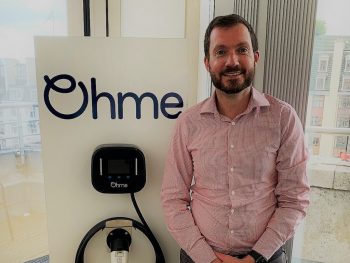Comment: Why data will become the crucial element in the EV shift
Ohme’s mobility director Peter McDonald examines how technology has changed the way fleets run and ponders how it can help efficiency levels.

Peter McDonald, Ohme director for mobility
Not so long ago, the role of a fleet manager was a detailed, but rather different one. A fleet of cars, a pack of fuel cards and drivers were, by and large, sent on their merry way.
Today, of course, things have become more complex. Technology has given this generation of fleet managers access to levels of information and technical detail that would have been unthinkable even a decade ago. But there is still a way to go to fully enable that level of technology and infrastructure with the fleets of tomorrow, particularly as they continue to embrace electrification.
An ever-growing percentage of those future fleets will be EVs, both cars and vans, whether that is through a business or personal leasing programme, salary sacrifice or the variety of other channels open to them. And, when it comes to charging those vehicles, the dominant model to date for most drivers remains home charging, which is both easier and cheaper than public access charging.
So those fleets and leasing companies will inevitably need an improved solution that can better integrate across their fleets, both vans and cars, and also potentially across markets too.
In the same way that global corporations use universal procurement programmes for their business essentials, so they can potentially do the same at scale for their EV charging. Increasingly, they will need providers that can standardise their services across multiple different markets when it comes to pricing, the customer journey, services and, perhaps most importantly, data.
Data dependence
Data will become the crucial element with the fleet switch to e-mobility. It will not only help fleet managers to better understand their fleets themselves, but will also help them to understand the usage of those fleets and how the vehicles are being used.
There’s no question that home charging is the prime solution for fleet buyers. It’s not just the lowest cost solution, it’s also the lowest CO2/kWh and also the lowest downtime solution too. Companies, both national and international, will have to look to charging companies such as Ohme that can help to manage the process of hardware selection and installation as well as ongoing access to charging times.
As Ohme expands its reach to mainland Europe and beyond in early 2024, we will be one of the only charging companies able to help fleet operators, both on that scalable level and with that level of in-depth knowledge and software capability with our online portal.
Future finances=
While some might cite the cost of fitting chargers to the homes of employees who have off-street parking, that cost is quickly subsumed by the potential savings. The most obvious of those is VAT. While there are ongoing parliamentary discussions about the VAT difference between home and public charging (electricity at home is charged at 5% VAT, while public charging is at 20%), for the time being that difference still remains.
Then there is the issue of the cost of electricity itself. At a CCS rapid charger, you can easily pay 79p/kWh and sometimes more, while at home the standard variable tariff is 29p (as from 1 January) – less than half the cost of public charging. For an average business EV driver covering 6,800 miles a year in a typical EV, the difference in cost between those two would mean an annual charging bill of either £493 or, are you sitting down, £1,343.
That canyon of difference is even more marked if your driver is on a dynamic smart EV tariff, such as Octopus Intelligent at 7.5p/kWh where those same annual miles would cost you just £127.50. That’s a potential saving of more than £1,200 on a single car over a single year, so it’s easy to see how those savings could build up on a larger fleet.
It’s not just those easily visible, on-paper savings either. By charging overnight and always starting the day with a full charge from their homes, drivers – particularly those in vans – will have less downtime and less time spent at public chargers. So there are savings in terms of man-hours to be had too.
And underpinning all of those factors is the importance of that data I mentioned earlier. Data and information will always be the fleet manager’s friend and that will become even more apparent as EV penetration grows within fleets. Fleet managers might have thought that they have already embraced technology in all its forms, but the reality is that relationship is only just beginning.
Peter McDonald is mobility director at Ohme. Prior to his current role, he spent two decades working for automotive manufacturers including Nissan, SEAT and the wider Volkswagen Group.

